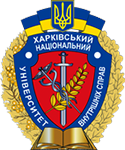Formation and development of special police units: a retrospective analysis
Abstract
The article analyses historical facts, requirements of laws and by-laws which regulated the activities of special police units in different periods through the prism of modern realities. It has been concluded that these units have gone through a rather long historical path of their formation and development, which we propose to divide into six stages. Stage I (1709–1917) – formation of the land militia, which can be considered the first example of the existence of modern special police units; Stage II (1917–1941) – characterised by the creation of Ukrainian voluntary militia and military formations; Stage III (1941–1978) – a period of stagnation in the history of the formation of special police units due to the events of the First and Second World Wars; Stage IV (1978–1991) – creation of the first special unit in the system of the Ministry of Internal Affairs of the USSR at the official level – a special police detachment; Stage V (1991–2014) – associated with Ukraine’s independence and the creation of Berkut special police unit, Titan special police unit, Sokil rapid response unit; Stage VI (2014 – present) – formation of special police units that actively participate in armed conflicts; this stage was influenced by three key events: 1) the anti-terrorist operation in eastern Ukraine, which was later called the “Joint Forces Operation”, which led to the creation of a number of volunteer special units of the Ministry of Internal Affairs of Ukraine; 2) the creation of the National Police of Ukraine and the formation of special units within its structure (the Rapid Action Corps, the Special Police Patrol Service and the Tactical Response Unit); 3) Russia’s full-scale invasion of Ukraine, which led to the creation of a militarised special police unit, the “Luty” Joint Assault Brigade of the National Police of Ukraine and the “Safari” assault regiment of the National Police.
Downloads
References
Bandurka, О. М., & Grechenko, V. А. (2021). Experience and conclusions of the organization of the activities of the militia of the Ukrainian SSR in 1948. European Perspectives, 3, 5–14. https://doi.org/10.32782/EP.2021.3.1.
Horiaha, О. V. (2014). Formation and activity of the Ukrainian landmilitia. Scientific Herald of International Humanitarian University. Series: Jurisprudence, 7, 14–18.
Kabachynskyi, М. І. (2005). History of Border Protection of Ukraine. The Bohdan Khmelnytskyi National Academy of the State Border Guard Service of Ukraine Publishers.
Kalashnyk, М. V. (2012). Problems of Formation of Workers’ and Peasants’ Militia at the Stage of Building Soviet Power in Ukraine. Jouranl of V. N. Karazin Kharkiv National University. Series “Law”, 11, 75–80.
Khudoba, I. S. (2017). Historical and legal analysis of development and establishment of military special inspectors. Law Bulletin, 5, 191–197.
Kotsan, І. D. (2003). Kharkiv Militia in 1917–1930 [Doctoral thesis, National University of Internal Affairs].
Kozynets, О. H., & Los, А. Yu. (2021). Activities of law enforcement agencies (militia) in the Soviet Ukraine in the 1920s – 1930s. Entrepreneurship, Economy and Law, 1, 182–187. https://doi.org/10.32849/2663-5313/2021.1.32.
Pavlovska, І. V. (2016). Organizational and legal principles of ensuring legality in the activities of the Ukrainian SSR militia (1919 – the first half of 1941) [Candidate dissertation, National Academy of Internal Affairs].
Pirko, V. О. (2007). Defensive structures in the interfluve of the Dnieper and Seversky Donets (historical essay with excerpts of sources and plans of structures for the second half of the XVII–XVIII centuries). Donetsk.
Rudyakov, P. М. (2019). Serbian Military Settlements of New Serbia and Slavic Serbia on Ukrainian Lands in the 18th Century (Part 1). Problems of World History, 3(9), 73–89.
Shatrava, S. О. (2006). Historical and legal aspect of the creation and development of special militia units. Bulletin of Kharkiv National University of Internal Affairs, 33, 254–262.
Shpytalov, H. H. (2013). Ukrainian Landmilicia. Kyiv.
Shyrochenko, V. М. (1999). “Sokil” is gaining momentum. “Sokil” rapid response units are five years old. Militia of Ukraine, 1–2, 24–25.
Tantsiura, V. І., & Peresada, О. О. (2013). History of Sloboda Ukraine. V. N. Karazin Kharkiv National University.
Vitvitskyi, S. S., Tulinov, V. S., Merdova, О. М. et al. (2021). Policing (S. S. Vitvitskyi, Ed.). Dakor.
Copyright (c) 2024 K. O. Chyshko, R. S. Pinchuk

This work is licensed under a Creative Commons Attribution 4.0 International License.



